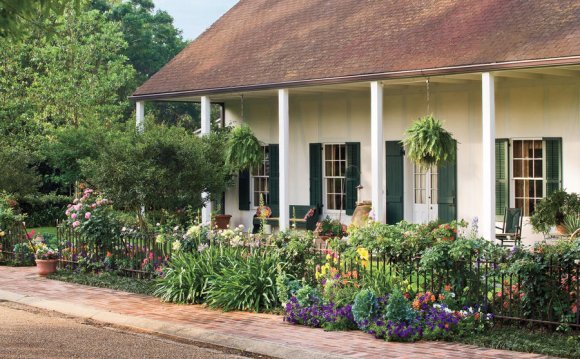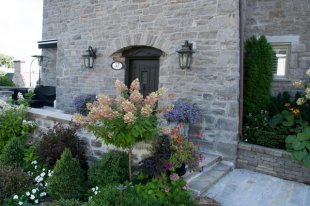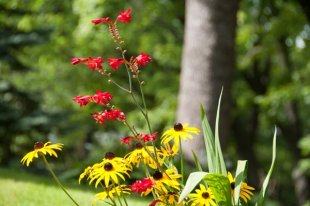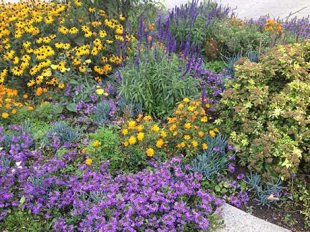
 Landscaping design rules make it easier to create a garden that has a touch of professionalism. They make the difference between a garden that passes unnoticed and one that gets people’s attention.
Landscaping design rules make it easier to create a garden that has a touch of professionalism. They make the difference between a garden that passes unnoticed and one that gets people’s attention.
You will find a list of general rules below, but you should also consider rules specific to front yards and backyards.
Landscaping design rules guide you throughout your project
Landscaping design rules don’t tell you how to create a plan for your yard, they are more useful towards the end of the planning process. So before you can start thinking design rules, you must have done the following:
- You have also considered practical issues, such as what you and others will do on the yard. Will children be running on the grass, or will people often be walking in specific areas? You have also marked this on your plan.
- You know precisely what you can and can’t do, after having checked every issue with your city or municipality, with your co-owners, spouse or whoever might have a say in your project.
- You have made a list of the features that you want to have in your landscaping. Do you want a patio to lounge outside and have drinks and meals? Do you want a fountain or a bird bath? Are there plants or trees that you definitely want to have?
With this information in hand, you are now ready to make major decisions about your project:
- What you want to add in terms of structures or surfaces (change the driveway, add a stone path leading to the backyard, etc.).
- What kinds of plants you would like to have (a lawn, specific varieties trees or bushes, flowers, etc.).
 Mixing colors and shapes
Mixing colors and shapes
Landscaping design rules are there to lend you a hand when it comes to assembling those building blocks. So the basic rules are as follows:
- Aesthetic factors, such as shape and color are important, but what is most important is to have the right plant in the right place. So you should always choose plants that correspond best to each specific location in terms of natural conditions and space. Only then will your plants really thrive and look their best.
- Landscaping design rules are not laws that apply the same way in every case. Tastes in terms of shapes and colors can vary a lot. Generally speaking, women tend to prefer plants that have lots of multicolored flowers, while men enjoy trees and bushes that have fewer flowers and colors. Some people find gardens that have only shades of green extremely beautiful, while others find them very unattractive. Choose a given theme for the whole project or choose various themes for different sections.
- When mixing colors, it is often best to choose complementary colors, as shown on the color wheel below (complementary colors are on opposite sides of the wheel).
- Most people prefer groups of plants and colors, so it may be better to have a bunch of tulips here and a bunch of daffodils there, or a patch of red here and a patch of yellow there, than to mix everything together and to spread things out over a larger area. The same can be said for trees. A big bunch of lilac trees in a corner looks better than a few small trees stretched out before a wall of fence.
- Creating sections within your yard using a fence and gate or garden arch may also give the impression that the yard is bigger than it is, plus it attracts attention and stimulates curiosity.
- Consider views and probable points of view. The most obvious point of view is just in front of your front door. If you stand there and look at your house and landscaping, what will you see and how well will you see it. Everything should be planted in a way that makes the best impression.
- When choosing plants, try to make a selection that will provide beauty over the whole growing season. Imagine a landscaping with nothing but tulips. Once spring is over, there is nothing left to admire.
- Try to find ways to draw attention away from what you don’t want people to see and attract the eyes to what you do want people to see.
 Hiding bad looking bricks behind a beautiful honeysuckle vine may be a very good idea, for instance. Planting beautiful white flowering plants below your beautiful bay window will attract light and make the house even more beautiful.
Hiding bad looking bricks behind a beautiful honeysuckle vine may be a very good idea, for instance. Planting beautiful white flowering plants below your beautiful bay window will attract light and make the house even more beautiful. - Asking around is rarely a bad idea, especially if you are uncertain about your own sense of taste. Better nurseries have employees who know a lot about gardening and landscaping. They will often be happy to give you a few pointers.
The following landscaping design rules are also important, although they do not apply to specific styles, such as the French or contemporary styles:
- You should try to make things look natural. In nature, you will never see plants lined up in parallel lines or circles. Your flower beds may be perfectly round or square, but your plants should follow a more natural pattern.
- Also consider drawing curves rather than straight lines. It somehow gives the impression that the space is larger than it really is.
As you can see, landscaping design rules are often rules of thumb, not to be taken literally and applied in every case.
A color wheel may help you mix colors. Red goes well with yellow because they are on opposite sides of the wheel. Red mixed with orange or purple looks rather bland.
Brainstorming
To brainstorm on possible designs, look at landscaping styles and pictures. Of course, you could also hire someone who knows all the landscaping design rules: a landscape designer or architect. Depending on the notoriety of the designer, the plan itself should cost from a few hundred dollars to a few thousand.Finally, you should know that it is more than likely that when you actually start work on your yard, unforeseen things will come up: pipes that you did not know were there, huge rocks that can’t be moved, old rubbish buried below the ground, etc. So you may end up having to change your final landscaping plan.
Taking pictures and drawing on them
To have a better idea of what your design will look like once your landscaping project is completed, take pictures of your house, enlarge them, print them on regular printer paper and draw your trees and bushes on them. You don’t have to be an artist. It’s only to give you an idea of sizes, colors and shapes. Another solution is to use a software program that lets you do the same on your computer.















